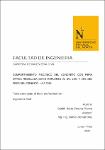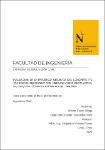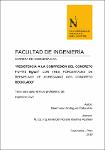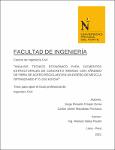Mostrar el registro sencillo del ítem
Comportamiento mecánico del concreto con fibra óptica reciclada como refuerzo al 5%, 10% y 15% del peso del cemento. Lima 2019
| dc.contributor.advisor | Bernal Díaz, Daniel | |
| dc.contributor.author | Chavez Rivera, Sadith Berta | |
| dc.date.accessioned | 2021-03-05T16:56:08Z | |
| dc.date.available | 2021-03-05T16:56:08Z | |
| dc.date.issued | 2020-11-25 | |
| dc.identifier.citation | Chavez, S. B. (2020). Comportamiento mecánico del concreto con fibra óptica reciclada como refuerzo al 5%, 10% y 15% del peso del cemento. Lima 2019 (Tesis de licenciatura). Repositorio de la Universidad Privada del Norte. Recuperado de https://hdl.handle.net/11537/25168 | es_PE |
| dc.identifier.other | 624.1834 CHAV 2020 | es_PE |
| dc.identifier.uri | https://hdl.handle.net/11537/25168 | |
| dc.description.abstract | El objetivo de la presente investigación es un diseño de mezcla determinando el porcentaje de fibra óptica reciclada como refuerzo, pudiendo ser 5%, 10% y 15% del peso del cemento, según la ACI 211. Se pretende utilizar fibra óptica reciclado como refuerzo del concreto, de esta forma se presenta una alternativa para el uso de materiales reciclados, con el fin de crear un concreto económico y amigable con el medio ambiente, beneficiando a la población en donde predomine el cable de fibra óptica reciclado. El proyecto de investigación se desarrolla, debido a la cantidad de residuos de cables de fibra óptica, que se generan día a día, causando malestar en la población, por ello se busca minimizar la contaminación ambiental, ya que se estaría demostrando que estos residuos tendrían un buen uso en la fabricación de un concreto experimental, el cual a su vez podría ser muy bien utilizado, no solo en la costa peruana, sino en zonas con intenso friaje. En primer lugar, se da a conocer la forma en que se puede aportar la fibra en el concreto para la elaboración del mortero experimental, en esta parte se describen los procedimientos y tratamiento para el plástico obtenido. Seguidamente se determina el porcentaje de fibra óptica reciclado , el cual proponemos 5%, 10% y 15% del peso del cemento, a utilizar como fibra de refuerzo para llegar a la resistencia de 210 kc/cm2 de un concreto experimental, para ello se estudia diferentes dosificaciones y determina las características mecánicas de cada una de ellas, a la vez se realizarán varios ensayos para determinar la cantidad de porcentaje que se cumplirá en todos los parámetros del material utilizando las normas peruanas y finalmente comparar la resistencia de un concreto convencional y el concreto experimental fabricado. | es_PE |
| dc.description.abstract | The objective of the present investigation is a mixture design determining the percentage of recycled fiber optics, which will partially replace the coarse aggregate to obtain a concrete f´c = 210 kg / cm2, according to ACI 211. It is intended to use recycled fiber optic cable granules as aggregate in the concrete mix replacing a fraction of commonly used fine aggregates (sand). In this way an alternative is presented for the replacement of natural aggregates with recycled materials, in order to create an economical and environmentally friendly concrete, benefiting the population where the recycled fiber optic cable predominates. The research project is developed, due to the amount of fiber optic cable waste, which is generated day by day, causing discomfort in the population, so it seeks to minimize environmental pollution, since it would be demonstrating that these residues would have a good use in the manufacture of an experimental concrete, which in turn could be very well used, not only on the Peruvian coast, but in areas with intense cold. First, the way in which the fiber can be provided in the concrete for the elaboration of the experimental mortar is disclosed, in this part the procedures and treatment for the plastic obtained are described. Next, the percentage of recycled optical fiber to be used to obtain an increase in the compressive strength of an experimental concrete is determined, for this purpose different dosages are studied and the mechanical characteristics of each of them are determined, at the same time several tests will be carried out to determine the amount of percentage that will be met to determine all the parameters of the material using Peruvian standards, to finally compare the strength of a conventional concrete and the experimental concrete manufactured. | es_PE |
| dc.description.uri | Tesis | es_PE |
| dc.format | application/pdf | es_PE |
| dc.format | application/msword | es_PE |
| dc.language.iso | spa | es_PE |
| dc.publisher | Universidad Privada del Norte | es_PE |
| dc.rights | info:eu-repo/semantics/openAccess | es_PE |
| dc.rights | Atribución-NoComercial-CompartirIgual 3.0 Estados Unidos de América | * |
| dc.rights.uri | https://creativecommons.org/licenses/by-nc-sa/3.0/us/ | * |
| dc.source | Universidad Privada del Norte | es_PE |
| dc.source | Repositorio Institucional - UPN | es_PE |
| dc.subject | Concreto | es_PE |
| dc.subject | Fibras ópticas - reciclado | es_PE |
| dc.subject | Materiales de construcción | es_PE |
| dc.title | Comportamiento mecánico del concreto con fibra óptica reciclada como refuerzo al 5%, 10% y 15% del peso del cemento. Lima 2019 | es_PE |
| dc.type | info:eu-repo/semantics/bachelorThesis | es_PE |
| thesis.degree.grantor | Universidad Privada del Norte. Facultad de Ingeniería | es_PE |
| thesis.degree.level | Título Profesional | es_PE |
| thesis.degree.discipline | Ingeniería Civil | es_PE |
| thesis.degree.name | Ingeniero Civil | es_PE |
| dc.publisher.country | PE | es_PE |
| dc.subject.ocde | https://purl.org/pe-repo/ocde/ford#2.01.01 | es_PE |
| thesis.degree.program | Pregrado | es_PE |
| dc.description.sede | Los Olivos | es_PE |
| renati.advisor.dni | 45128042 | |
| renati.advisor.orcid | https://orcid.org/0000-0003-0863-8343 | es_PE |
| renati.author.dni | 41711514 | |
| renati.discipline | 732016 | es_PE |
| renati.juror | Canta Honores, Jorge Luis | |
| renati.juror | Quesada Llanto, Julio Christian | |
| renati.juror | Vega Rivera, Gerson Elías | |
| renati.level | https://purl.org/pe-repo/renati/level#tituloProfesional | es_PE |
| renati.type | https://purl.org/pe-repo/renati/type#tesis | es_PE |
Ficheros en el ítem
Este ítem aparece en la(s) siguiente(s) colección(ones)
-
Tesis [1449]








